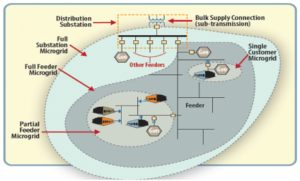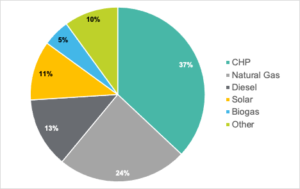
By Lynn A. Kirshbaum, Deputy Director of the Combined Heat and Power Alliance
The nation’s electric grid is a highly interconnected system: impacts to the grid in one location can affect communities far away. According to the latest National Climate Assessment, climate-related impacts increase risks for critical, interconnected systems, many of which span regional and national boundaries. Investing in smaller grid structures powered by clean energy sources, such as microgrids powered by CHP systems, can help to mitigate these risks.
The U.S. Department of Energy (DOE) describes microgrids as “localized grids that can disconnect from the traditional grid to operate autonomously.” CHP systems can provide reliable power to a local community as part of a microgrid, allowing several buildings or facilities to keep the lights on during a grid outage. Microgrids are used by universities, military installations, municipalities, and public institutions, helping to maintain the reliability of their electric and thermal energy supply and to improve their resiliency against extreme weather and power outages. In some locations, a number of critical facilities such as hospitals, fire and police stations, emergency shelters, and gas stations can be connected and configured to operate in isolation from the larger utility grid, even during extended outages.
The Role Microgrids in Helping Advance the Nation’s Energy System

Source: U.S. Department of Energy. Office of Electricity. “The Role of Microgrids in Helping to Advance the Nation’s Energy System.” https://www.energy.gov/oe/activities/technology-development/grid-mod-ernizationand-smart-grid/role-microgrids-helping
Microgrids strengthen grid resilience and mitigate grid disturbances for these users by localizing power generation close to critical services and providing faster system response and recovery. As of 2016, CHP was the primary generation technology for existing microgrids and is expected to be implemented in future microgrid projects. CHP currently provides 37% of the capacity in existing microgrids.
Microgrids in the U.S. by Technology Type (% of Total Generating Capacity)

Consulted ICF Microgrid Database and determined CHP’s capacity in operational microgrids.
CHP systems are more reliable than conventional backup generators because they supply continuous thermal and electric energy and they frequently utilize natural gas infrastructure, rather than relying on deliverable fuels. This makes CHP-fueled microgrids a resilient solution to support critical infrastructure such as hospitals, colleges and universities, wastewater treatment plants, and airports.
CHP-powered microgrids are becoming more prevalent in community resilience planning with multiple stakeholders because of their ability to provide continuous power to critical infrastructure and limit the impact of outages by localizing power generation close to critical services. CHP systems not only provide the benefit of essential energy services during catastrophic weather events and emergencies, but can also create cost savings, distribution capacity, power quality benefits, and environmental benefits for an entire community.
In general, CHP can play a significant role in decarbonizing the electricity, buildings, and industrial sectors: in almost all regions of the U.S., CHP systems installed through 2035 and operating through 2050 are expected to cause a net reduction in carbon emissions over their system life. CHP systems require less fuel inputs for the same energy outputs and have a high capacity factor allowing them to displace high-emitting marginal grid resources.
In addition, CHP can help to reduce emissions overall by providing a consistent source of power that allows more intermittent renewables to be added to the electric grid. CHP serves as an enabling technology to further integrate renewable energy into the fuel mix at the community level.
Microgrids powered by CHP units can also enable renewable resources as part of a microgrid. Similar to a centralized electric grid, a microgrid generates, distributes, and regulates the supply of electricity, but on a small scale. Microgrids may have more than one source of electric generation and serve multiple buildings or loads.
Sites with thermal demand that is met by an integrated CHP system may be able to establish a cost-effective microgrid that includes a renewable energy system. Microgrids that combine CHP systems with renewable energy resources significantly reduce carbon emissions per unit of electricity consumed at the site by capturing and using the waste heat of combustion and minimizing transmission losses.
Want to learn more about CHP as a climate change solution? Read our report, CHP and a Changing Climate: Reducing Emissions and Improving Resilience.
Want to stay updated about future CHP Alliance events? Click here to be added to our mailing list.
